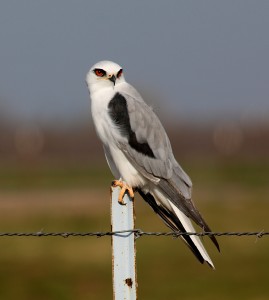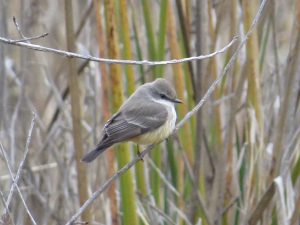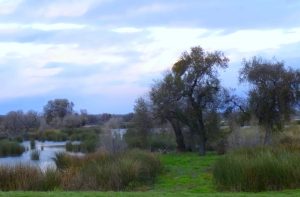
Last Monday morning, an ambitious birder said she had high hopes for seeing a bright red bird. Local birders of the hard core variety knew Sharon Reeve was hoping to see a Vermilion Flycatcher, a winter rarity that resides many miles south of the Valley. The species had been recorded only twice previously in Stanislaus County.
Over a dozen birders, most of them members of the Stanislaus Audubon Society Board of Directors, had gathered for the Caswell/Westley Christmas Count, a local outing that is part of the Audubon Christmas Count. Now a world-wide event, the Christmas Count began over one-hundred years ago on Christmas Day, 1900, with 27 birders conducting 25 counts in cities as far apart as New York, Ontario Canada, and Pacific Grove, California.
That day, before modern optics and popular bird guides, the 27 widely-scattered birders tallied 90 species on all their counts combined. Monday, January 2, Stanislaus Audubon Society birders counted over 135 species just within a fifteen mile radius circle in northwestern Stanislaus County, with a bit of overlap into southern San Joaquin County.
Among the birds recorded was a Vermilion Flycatcher, but it wasn’t red because the female of this species is pale brown, with yellowish-orange underparts. It’s far less colorful than the neon-bright male. Instead of a red bird, Sharon Reeve and her husband Harold got to see what was very likely the same tiny bird they had seen in the same place some four years earlier—a female Vermilion Flycatcher.

The bird was hawking insects along a small pond in a restricted area protected by the U.S. Fish and Wildlife Service, within the San Joaquin River National Wildlife Refuge. And despite the odds against it, other Valley records of Vermilion Flycatcher, predominantly males, have featured birds that returned to the same location year after year. This tiny bird may have found its way back as well.
The Reeves also saw tens of thousands of waterfowl, including large flights of the formerly endangered Aleutian Canada Goose. Their final tally for the day included sparrows, warblers, Bald and Golden Eagles, night herons, egrets, wrens, kinglets, and woodpeckers.
The birding bonanza was in large part the result of a coordinated effort among private landowners, the U.S. Fish and Wildlife Service, the State of California, River Partners, and myriad others to restore wetlands and riparian forests near the confluence of the Tuolumne, Stanislaus, and San Joaquin Rivers. Habitat restoration was called for when the Aleutian Goose population dropped to under 600 individuals in the 1980s, and was officially declared endangered.
Today, there are close to 150,000 Aleutian Canada Geese, and the vast majority winter here in the northern San Joaquin Valley. As is inevitably the case with endangered species, protecting their habitat enabled a huge variety of associated wildlife to flourish, hence a birding bonanza.
Over one-hundred years of consistent data have made the Audubon Christmas Count a valuable tool for tracking environmental change, and the count results often send a warning when bird numbers drop precipitously. Unfortunately, even though Stanislaus Audubon birders had a banner day as they enjoyed the spectacular overflights of waterfowl and diverse other bird species, they also recorded a sobering statistic.

Earlier in the history of the Caswell-Westley Count, that count circle had recorded the largest number of White-tailed Kites in the nation. A spectacular raptor that was once threatened by random shooters, the kite has always been a favorite of anyone who’s ever had a close look at this beautiful creature. It rebounded from low numbers when shooting raptors was outlawed.
Unfortunately, the proliferation of almond orchards throughout the San Joaquin Valley has had a negative effect on all species that forage on open rangeland, and the kite is no exception. Despite much searching for kites within a territory that once led the nation, Audubon birders found only one this year. It was a sobering note on an otherwise glorious day.
Frequent encounters with birds inspire not only a love of nature, but optimism and resolve as well. As birders contemplated the likelihood that a tiny bird weighing about half an ounce had somehow found refuge hundreds of miles north of its normal habitat, braving wind, rain, and winter cold, they also held out hope the White-tailed Kite would prevail even against a huge and threatening forest of almonds. Such is the power of nature.
